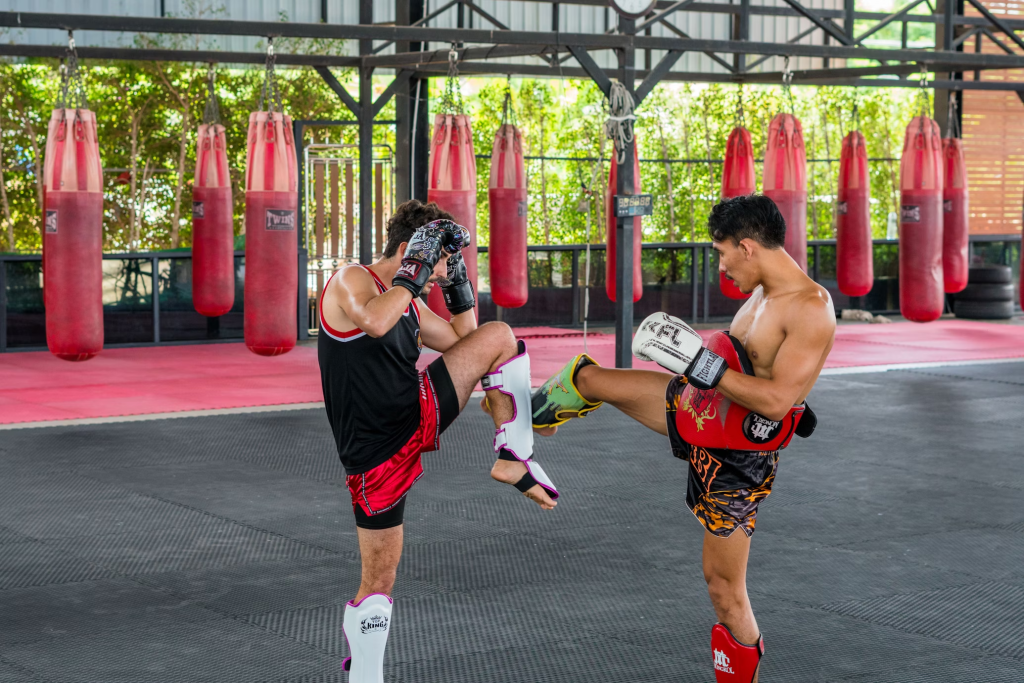Boxing classes have become popular for individuals seeking a mix of physical conditioning and practical self-defence skills. Unlike traditional gym routines, boxing combines movement, strength, speed, and technique, making it an engaging and rewarding way to stay fit.

In addition to its clear health advantages, boxing provides essential tools for self-defence in a threatening situation. This article delves into the core benefits of boxing for fitness and self-defence, supported by expert sources and practical insight.
For a deeper look into how to get started, visit this site right here.
Physical Fitness Benefits Of Boxing
Boosts Cardiovascular Health
Boxing is an intense aerobic workout that keeps your heart pumping throughout the session. Training typically involves:
- Skipping
- Pad work
- Heavy bag drills
- Sparring
- Circuit training
These high-paced activities elevate the heart rate and improve cardiovascular endurance. Over time, this can lead to reduced blood pressure, better circulation, and improved heart efficiency. According to Healthline, regular boxing can lower the risk of heart disease, strokes, and diabetes.
Supports Weight Loss And Body Fat Reduction
Boxing burns a significant number of calories. A one-hour session can expend up to 800 calories, depending on intensity. This high-calorie burn contributes to:
- Weight management
- Reduction in body fat percentage
- Faster metabolism
Boxing involves full-body movement, meaning calories are burned from all major muscle groups. Combined with a proper diet, boxing effectively trimmed fat and sculpted lean muscle.
Improves Muscle Tone And Functional Strength
While it may seem like an upper-body-focused sport, boxing works the entire body. Regular classes develop:
- Strong shoulders, arms, and back from punching
- Core strength from twisting and balancing
- Leg power through footwork and lower-body movements
This makes boxing functional, enhancing practical strength rather than isolated muscle gain. It’s ideal for those who want a toned body rather than bulky muscles.
Enhances Coordination And Reflexes
One of the foundational skills in boxing is the ability to coordinate hand and foot movements. Boxers must:
- Throw combinations while moving
- Defend against incoming strikes
- Maintain balance while executing complex footwork
Improving these skills sharpens reflexes and enhances neuromuscular coordination. This benefit is useful inside the ring and translates to everyday tasks, particularly for older adults who need to maintain balance and prevent falls.
Increases Endurance And Stamina
Boxing is a test of both physical and mental stamina. Repeated rounds of high-intensity combinations, combined with active rest periods, train the body to recover quickly. With consistent practice, individuals experience:
- Greater muscle endurance
- Better control of breathing
- Less fatigue in daily activities
This improved stamina makes other forms of exercise feel more manageable and supports an overall active lifestyle.
Builds Core Stability And Posture
Boxers rely heavily on their core for every movement. The abdominal and oblique muscles are constantly engaged from punching to pivoting and ducking. This leads to:
- Stronger core muscles
- Improved spinal alignment
- Reduced risk of back pain
Boxing can correct postural imbalances, especially for those who spend long hours sitting. It reinforces proper alignment by encouraging active trunk engagement throughout training.
Self-Defence Advantages Of Boxing
Practical And Efficient Striking Techniques
Boxing teaches some of the most efficient striking methods in martial arts. Unlike styles that use flashy or complex moves, boxing focuses on:
- Straight punches (jabs and crosses)
- Hooks
- Uppercuts
- Body shots
These techniques are powerful and straightforward, making them applicable in real-world scenarios. Boxing footwork also allows quick entry and exit, helping people defend themselves and escape danger.
Defensive Skills That Protect You
Boxers learn how to avoid, block, and absorb punches through techniques such as:
- Slipping (moving the head to avoid punches)
- Parrying (redirecting strikes)
- Rolling (ducking under punches)
- Guarding (using gloves and arms to block)
These movements sharpen reflexes and promote quick decision-making under pressure. Knowing how to move your head or shield your body during a confrontation can differentiate between getting hurt and walking away safely.
Conditions The Body To Handle Stress
Self-defence isn’t only about technique—it’s about staying calm under pressure. Boxing helps condition the body and mind to remain composed when adrenaline kicks in. Sparring sessions simulate high-pressure situations where you must:
- Read an opponent’s movements
- Decide how to respond
- Execute your plan despite fatigue
This mental conditioning makes it easier to stay focused during emergencies and respond appropriately.
Builds Fighting Fitness
Stamina and power matter if you’re ever forced to defend yourself physically. Boxing develops what’s known as “fighting fitness,” including:
- Cardio capacity to sustain activity
- Explosive power for effective strikes
- Strong legs for mobility and quick escapes
You don’t have to be a professional fighter to benefit from these attributes. In any confrontational situation, having better fitness can increase your chances of protecting yourself successfully.
Teaches Control And Restraint
Boxing isn’t about promoting violence. It teaches when to fight—and more importantly, when not to. Through proper training, individuals learn:
- Situational awareness
- Risk assessment
- Emotional regulation
Trained individuals are less likely to escalate a situation unnecessarily. They have the confidence and ability to de-escalate or walk away without fear.
Improves Reaction Time And Spatial Awareness
A key advantage of boxing is the development of reaction speed. Boxers must react quickly to punches and make decisions in fractions of a second. This translates to:
- Faster reactions in everyday life
- Enhanced perception of surroundings
- Sharper decision-making under stress
These are essential skills for avoiding danger, identifying threats early, and taking the safest action.
Prepares You To Handle Real-World Encounters
While boxing is a sport, its techniques apply to real self-defence scenarios. In situations involving:
- One-on-one aggression
- Close-quarters threats
- Attacks without weapons
Boxing’s skill set is highly effective. The ability to move efficiently, strike decisively, and recover quickly is are real-world advantage that cannot be understated.
Additional Benefits Of Boxing Training
Structured And Progressive Learning
Boxing classes are typically structured around:
- Warm-ups and drills
- Technical practice
- Pad work or bag training
- Conditioning circuits
This ensures a balanced approach to learning and progressing. Beginners can start with basic footwork and punches, then gradually build toward sparring or competition-level drills. The structure supports long-term development and measurable progress.
Customisation For Different Goals
Boxing caters to various personal goals. You can train for:
- Fitness and weight loss
- Stress relief
- Competitive aspirations
- Self-defence preparation
Training intensity and focus can be adjusted based on age, fitness level, and objectives, making boxing accessible to teenagers, adults, and seniors.
Accessibility And Affordability
Compared to many martial arts that require expensive gear or complex enrollment, boxing is relatively accessible. Many gyms offer:
- Group classes
- Personal training options
- Equipment rental (gloves, wraps)
The simplicity of the sport makes it beginner-friendly and cost-effective.
Conclusion
Boxing is far more than a sport—it’s a full-body workout and a powerful self-defence tool. It delivers well-rounded benefits, from improving heart health and burning fat to learning real-world striking techniques.
With consistent training, individuals improve their physical fitness and gain the knowledge and confidence to protect themselves. Whether seeking to get in shape or looking for practical self-defence, boxing offers a reliable and engaging path forward.
Frequently Asked Questions
Can Beginners Join Boxing Classes Without Prior Experience?
Yes, boxing classes are designed to accommodate all fitness levels, including complete beginners. Instructors typically focus on teaching fundamental techniques, basic footwork, and safe training habits. Beginners can gradually progress at their own pace while building strength and confidence. It’s always best to inform the trainer about your experience level so they can provide appropriate guidance.
Is Boxing Effective For Real-Life Self-Defence Situations?
Boxing is highly effective for self-defence, especially in one-on-one scenarios. It teaches quick, powerful striking and defensive skills like slipping, blocking, and footwork that can help avoid or escape danger. The mental conditioning from training also helps you stay calm and make fast decisions under pressure. However, like any self-defence method, awareness and avoidance should always be prioritised when possible.
How Often Should I Attend Boxing Classes To See Results?
Attending boxing classes 2–3 times a week is generally enough to notice improvements in fitness, coordination, and technique within a few weeks. Consistency is key; combining training with proper nutrition and rest will speed up results. As you become more experienced, you can increase your frequency based on your goals. Beginners should focus on steady progress rather than intensity alone.
